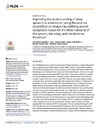Identificador persistente para citar o vincular este elemento:
https://accedacris.ulpgc.es/jspui/handle/10553/41760
| Título: | Improving the understanding of sleep apnea characterization using Recurrence Quantification Analysis by defining overall acceptable values for the dimensionality of the system, the delay, and the distance threshold | Autores/as: | Martín-González, Sofía Navarro-Mesa, Juan L. Juliá-Serdá, Gabriel Ramirez-Avila, G. Marcelo Ravelo-García, Antonio G. |
Clasificación UNESCO: | 3314 Tecnología médica | Palabras clave: | Heart-Rate-Variability Cardiovascular-System Embedding Dimension Nonlinear Dynamics Network Physiology, et al. |
Fecha de publicación: | 2018 | Proyectos: | MAC/1/C121 | Publicación seriada: | PLoS ONE | Resumen: | Our contribution focuses on the characterization of sleep apnea from a cardiac rate point of view, using Recurrence Quantification Analysis (RQA), based on a Heart Rate Variability (HRV) feature selection process. Three parameters are crucial in RQA: those related to the embedding process (dimension and delay) and the threshold distance. There are no overall accepted parameters for the study of HRV using RQA in sleep apnea. We focus on finding an overall acceptable combination, sweeping a range of values for each of them simultaneously. Together with the commonly used RQA measures, we include features related to recurrence times, and features originating in the complex network theory. To the best of our knowledge, no author has used them all for sleep apnea previously. The best performing feature subset is entered into a Linear Discriminant classifier. The best results in the "Apnea-ECG Physionet database" and the "HuGCDN2014 database" are, according to the area under the receiver operating characteristic curve, 0.93 (Accuracy: 86.33%) and 0.86 (Accuracy: 84.18%), respectively. Our system outperforms, using a relatively small set of features, previously existing studies in the context of sleep apnea. We conclude that working with dimensions around 7-8 and delays about 4-5, and using for the threshold distance the Fixed Amount of Nearest Neighbours (FAN) method with 5% of neighbours, yield the best results. Therefore, we would recommend these reference values for future work when applying RQA to the analysis of HRV in sleep apnea. We also conclude that, together with the commonly used vertical and diagonal RQA measures, there are newly used features that contribute valuable information for apnea minutes discrimination. Therefore, they are especially interesting for characterization purposes. Using two different databases supports that the conclusions reached are potentially generalizable, and are not limited by database variability. | URI: | https://accedacris.ulpgc.es/handle/10553/41760 | ISSN: | 1932-6203 | DOI: | 10.1371/journal.pone.0194462 | Fuente: | PLoS ONE [ISSN 1932-6203], v. 13 (e0194462) |
| Colección: | Artículos |
Citas SCOPUSTM
28
actualizado el 08-jun-2025
Citas de WEB OF SCIENCETM
Citations
23
actualizado el 08-jun-2025
Visitas
109
actualizado el 02-mar-2024
Descargas
96
actualizado el 02-mar-2024
Google ScholarTM
Verifica
Altmetric
Comparte
Exporta metadatos
Los elementos en ULPGC accedaCRIS están protegidos por derechos de autor con todos los derechos reservados, a menos que se indique lo contrario.
